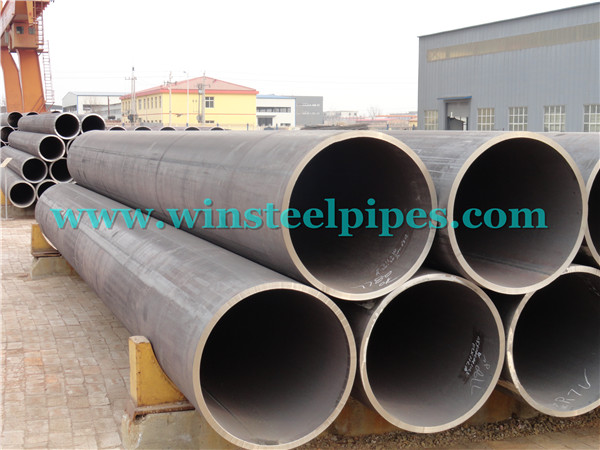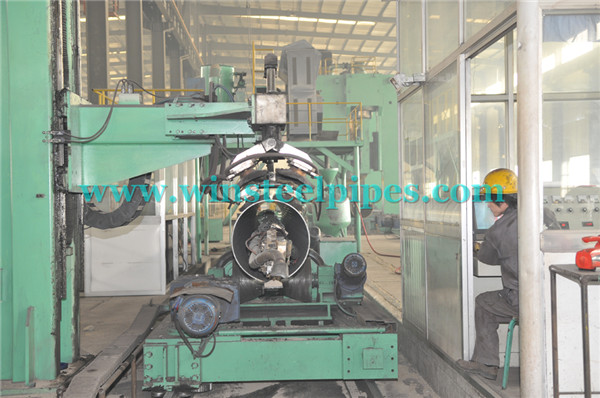Let’s see the LSAW Pipe Manufacturing process. The plate rolled in the circular section with the help of a plate bending machine. Once the circular section rolled from the raw material. In next step pipe is weld with the pressure of welding setup. LSAW pipe can be welding with or without filler material. Using an appropriate welding method.

Winsteel Group as a professional LSAW pipe welding factory. We have got API 5L & ISO certificate for more than decade years.
Welded Pipes made by LSAW pipe mill are using steel plate as raw material. It is different from SSAW pipe.
SSAW steel pipe is using steel coils as raw material.
LSAW Pipe Manufacturing Process

1. Plate Stock and inspection
Take ultrasonic testing for steel plates before they put into the production line. This kind of steel plate used for welding large-diameter LSAW pipes.
2. Edge preparation milling
Use a milling machine to shape both sides of the steel plate. So as achieve the required plate dimension, the parallelism of the plate edge.
3. Pre-bending
To pre-bend the plate edge to meet the required curvature using a pre-bending machine.
4. Shaping:
Use a JCO shaper to stamp1/2 of the pre-curved plate. Pressing it into a “J” form, then bend the left 1/2, forming a “C” form and an open “O” shape finally. For double seam saw pipe, the first two halves joined by tack weld which called fit-up. Double seam saw pipe is having a two weld seam opposite to each other. Both the welding seams welded from the internal and external of the steel pipe. In the case of heavy thickness steel pipe, multiple pass welding done.
5. Pre-welding
Joint the seam of shaped straight welded pipe. And use gas shielded welding (MAG) for continuous welding.
6. Internal & external welding
Use multiple wires submerged arc welding for inner parts and external of the LSAW steel pipes.
7. Weld seam ultrasonic testing I :
Take 100% ultrasonic test in the inner and outer welding seams. And their base material on both sides of longitudinally welded steel pipes.
8. X-ray Inspection I:
Use 100% X-ray to examine the inner and outer welding seams. And make sure the sensitivity of the testing by using an image Processing system.
9. Mechanical Expanding:
Expand the full length of the LSAW pipe to improve its dimensional accuracy. And to distribution of internal stress.
10. Hydrostatic testing
Check the expanding LSAW pipe one by one on the hydraulic testing machine. To ensure that the LSAW pipe can meet the required testing pressure. Hydraulic testing machines have automatic recording and storage functions.
11. End-facing and beveling
Process the end of the qualified pipe to achieve the required groove size.
12. Ultrasonic Test II:
Use the ultrasonic test to check LSAW pipes one by one. So that we can find out possible defects after expanding and hydraulic processes.
13. X-ray Inspection II
Use X-ray to test LSAW pipes which expanded. and hydraulical tested and shoot X-ray film for the welding seams.
14. Pipe Ends Magnetic Particle Examination
Use magnetic particle examination to examine defects of pipe ends.
15. Anti-corrosion and Coating
Take the treatment of corrosion and coating for the qualified steel pipe according to users’ requirements. If you want to learn more about LSAW pipe coating, please the article “LSAW pipe coating”
16. Marking
Types of Marking Techniques:
- (1) DIE STAMPING: Process in which an engraved die is used to cut and stamp (leave an impression).
- (2) PAINT STENCILLING: Produces an image or pattern by applying pigment to a surface over an intermediate object with gaps in it which create the pattern or image by only allowing the pigment to reach some parts of the surface. More details about LSAW steel pipe marking, please see “LSAW Steel Pipe Marking”
Once the welding is completed heat treatment is carried out on the weld. Or on the full body of pipe, this depends on the thickness of pipes. Weld seams are also subjected to various non-destructive testing such as RT & UT. To ensure the soundness of the weld material.
Once all NDT is completed pipes are hydro tested to ensure strength. And ability to remain leak-proof under pressure. In the last stage of inspection, the pipe is checked visually and dimensionally by a competent inspection engineer.
He will ensure that the pipe is meeting the code, standard, and specification requirements. Once the Inspection engineer cleared the pipe, it will mark as per the standard requirements & send for the packaging.